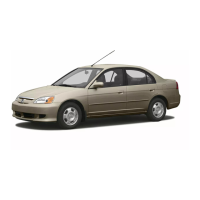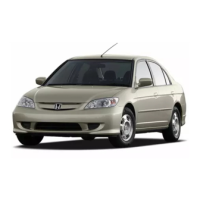
Do you have a question about the Honda 2008 Civic Hybrid and is the answer not in the manual?
| Brand | Honda |
|---|---|
| Model | 2008 Civic Hybrid |
| Category | Automobile |
| Language | English |
Key safety recommendations for occupant protection and vehicle operation.
Overview of passive safety features like airbags, seat belts, and structural elements.
Detailed information on the proper use and importance of seat belts for safety.
Explanation of the supplemental restraint system and how airbags function.
Guidelines for safe seating positions and seat belt usage for adults and teenagers.
Essential rules for safely restraining children of all ages in the vehicle.
Specific guidance on using child seats for infants and young children.
Recommendations for seat belt fit, booster seats, and safe seating for older children.
Information on the dangers of carbon monoxide and how to avoid exposure.
Location and importance of safety warning labels on the vehicle.
Diagram showing the location of various controls within the vehicle for easy access.
Overview of the vehicle's instrument panel layout and displays.
Explanation of the various warning lights and indicators on the instrument panel.
Description of the vehicle's gauges, including fuel, temperature, and odometer.
Location and function of controls mounted on or near the steering wheel.
Information on vehicle keys, remote transmitters, and security systems.
Explanation of the anti-theft immobilizer system and its operation.
Details on the ignition switch positions and how to start the vehicle.
Information on power door locks, childproof locks, and auto locking/unlocking features.
Instructions for adjusting front seats, seat backs, and head restraints for comfort and safety.
Operation of the power window system, including automatic and safety features.
Guidance on adjusting interior and exterior mirrors for optimal visibility.
How to apply and release the parking brake and its importance.
Description of various interior storage and convenience features like cup holders and glove box.
Operation of the heating, ventilation, and air conditioning system for cabin comfort.
How to operate vehicle functions using voice commands (requires navigation system).
Explanation of the automatic climate control system's features and operation modes.
Guide to operating the vehicle's audio system, including radio, CD, and XM features.
Information about the vehicle's anti-theft security system and its operation.
Instructions on how to use the cruise control system for maintaining a set speed.
Recommendations for the initial driving period to ensure vehicle reliability and performance.
Information on the type of gasoline and additives recommended for optimal engine performance.
Guidance on refueling and basic checks performed at a service station.
Step-by-step instructions on how to safely refuel the vehicle's fuel tank.
Procedures for safely opening and closing the vehicle's hood.
How to check the engine oil level and what to do if it is low.
Instructions on checking the engine coolant level and ensuring it is within the proper range.
Information on factors affecting fuel economy and how to improve it.
Warnings and guidelines regarding the installation of accessories and vehicle modifications.
Advice on safely storing items and cargo within the vehicle to maintain stability.
Pre-drive checks and adjustments for safe vehicle operation.
Procedures for starting the engine, including cold weather and flooded engine conditions.
Explanation of the Continuously Variable Transmission's operation and shift lever positions.
Proper procedures for parking the vehicle, including the use of the parking brake.
Overview of the vehicle's braking system, including power assist and regenerative braking.
How the ABS system works and how to use it effectively during braking.
Information regarding the vehicle's inability to tow trailers and associated warranty implications.
Explanation of the TPMS, its indicators, and the importance of proper tire inflation.
Essential safety precautions to follow when performing vehicle maintenance.
How to understand and reset the maintenance minder system for timely service.
Diagram showing the location of key vehicle fluids for checking and refilling.
Instructions on selecting and adding the correct engine oil to maintain performance.
Procedures for changing the engine oil and filter, including necessary tools and steps.
Guidance on checking and adding engine coolant to the cooling system.
How to check and refill the windshield washer fluid reservoir.
Procedures for checking and maintaining the automatic transmission fluid level.
Instructions on checking the brake fluid level and its importance for safety.
Information on various vehicle lights, including aiming and replacement procedures.
Guidance on cleaning wheels and maintaining tires for optimal performance and safety.
Information on the proper use and precautions for the temporary compact spare tire.
Step-by-step instructions for safely changing a flat tire.
Troubleshooting steps for diagnosing and resolving engine starting issues.
Procedures to follow if the vehicle's engine overheats, including safety warnings.
Explanation of the low oil pressure indicator and what to do if it illuminates.
Information on the charging system indicator and potential causes when it illuminates.
Explanation of the malfunction indicator lamp and emissions readiness codes.
Understanding the brake system indicator, including ABS and power-assist warnings.
Overview of the vehicle's fuse system and locations.
Diagrams showing the location and circuit protection for all vehicle fuses.
Guidelines and precautions for safely towing the vehicle in emergency situations.
Information on locating various vehicle identification numbers like VIN and engine numbers.
Technical specifications of the vehicle, including dimensions, weights, capacities, and engine details.
Explanation of tire grading standards for treadwear, traction, and temperature.
Understanding the markings on tire sidewalls, including size, load, and speed ratings.
Federal explanation of the TPMS and its function in monitoring tire pressure.
Overview of the vehicle's emissions control systems and how they work to reduce pollution.
Contact information and advice for resolving issues with dealerships and Honda customer service.
Summary of the vehicle's warranty coverage for different components and systems.
Information on how to report potential safety defects to NHTSA and Honda.
Information on how to purchase factory-authorized service and owner manuals.












